Once upon a time, root cellars were the only way people had to preserve their food. These wonderful cold-storage areas became less common when refrigerators became affordable. Houses were no longer automatically built with a root cellar beneath or nearby.
A root cellar is still a great way to store fruits and vegetables, though, especially when you need to store more than you have room for indoors. They will also keep the fruits and vegetables fresh without electricity. If your house doesn’t have one, you can still take advantage of nature’s “ice box.” All it takes is a shovel, a little elbow grease and a trash can.
Related: Living without a Refrigerator – It Can Be Done!
The Basic Concept
Root cellars are built underground, usually just below the frost line. The ground stays cool at that depth but it does not freeze. Some sort of ventilation allows for air movement to help prevent rot, although the vents are closed for the winter. Vegetables and fruits are kept cool under these conditions but do not freeze. They stay fresh and ready to eat throughout the cold winter months.
The Modern Root Cellar
You don’t have to rent a front-end loader and dig a root cellar to take advantage of nature’s natural food-preserving abilities. A very efficient modern root cellar can be made from a hole in the ground and a container. This type of root cellar is actually a bit of an improvement over the old style. You can have a number of smaller, individual root cellars rather than one big one. Vegetables and fruits can be kept separate and you can just access the root cellar you need. You don’t have to go digging through various vegetables to get the one you want.
What You Will Need:
- Dirt shovel
- Trash can (galvanized steel or plastic)
- Drill or hammer and nail
- Straw
- Rocks
- Plywood
The depth of the hole should be adjusted according to your freeze line or how deep the soil freezes in your area. Be sure to dig deep enough for the can to sit on the rocks at the bottom of the hole and still be at or just below the freeze line.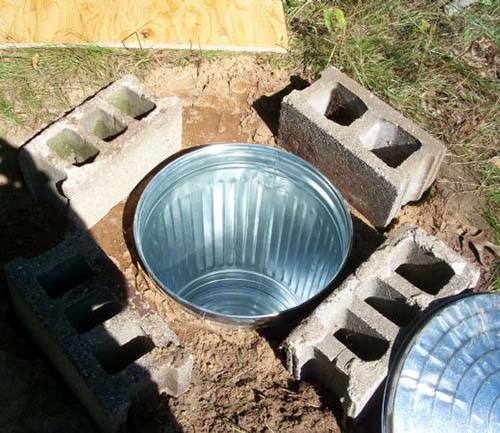
Place the root cellars in sandy soil and/or in a slightly elevated area. Do not put them where water tends to saturate the ground and does not quickly drain away. You want some humidity but you don’t want the fruits and vegetables to be saturated. Excess water in the bottom of the can will also interfere with proper ventilation. You want to make sure there will be some air movement from the holes in the bottom of the can.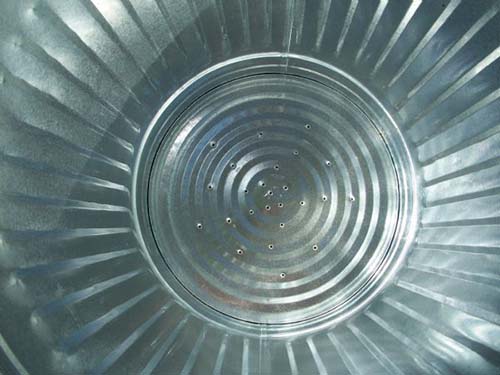
Install separate root cellars for fruits and vegetables. They should not be stored together within the same can, even if they are separated with straw. Fruits give off ethylene which will cause vegetables to ripen and rot. They also cause potatoes to sprout.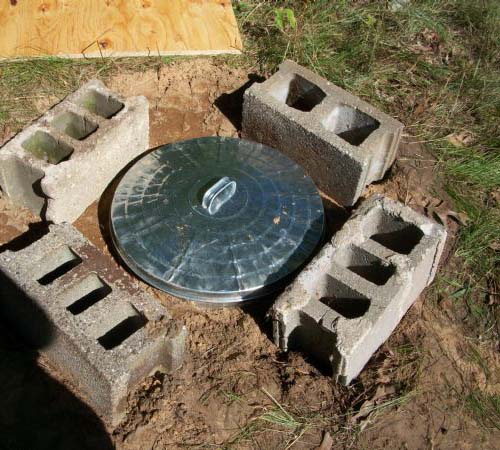
Vegetables that Store Well Together
Many vegetables have similar temperature and humidity requirements.
The following can be stored together within the same can at 32 to 40 degrees F/0 to 4 degrees C at 90 to 95% humidity:
- Beets
- Brussels sprouts
- Cabbage
- Carrots
- Cauliflower
- Celery
- Endive
- Horseradish
- Kale
- Leeks
- Turnips
Do not store damaged vegetables but do leave them dirty.
Just brush off most of the dirt. Do not rinse them or wash them. Use damaged fruits and vegetables right away. Bacteria and fungus will quickly take hold on bruised or cut produce.
Store onions in a cool, dry root cellar with temperatures of 32 to 35 degrees F/0 to 1 degree C and 60 to 70% humidity after you shock them. Shock them by bending or snapping the green stems 1 month before harvest. You can store peas with onions.
Regular potatoes and sweet potatoes need to be stored separately. Regular potatoes should be kept at 38 to 40 degrees F/3 to 4 degrees C and 80 to 90% humidity. Sweet potatoes should be kept at 50 to 55 degrees F/10 to 13 degrees C with 80 to 90% humidity.
Dried beans need to be kept cool and dry with temperatures between 32 and 50 degrees F/0 and 10 degrees C in 60 to 70% humidity.
Pumpkins and squash can be stored together in a warm, dry root cellar. Temperatures should be kept between 50 and 55 degrees F/10 and 13 degrees C with 60 to 75% humidity.
Store apples and pears in a cold, moist root cellar with temperatures of 32 to 40 degrees F/0 to 4 degrees C in 80 to 90% humidity.
If you notice your fruits or vegetables beginning to shrivel, the humidity level is too low. Try misting the layers of straw with a little water to increase moisture levels. If there is a little condensation or moisture on the fruits or vegetables, you will need to reduce the humidity in the root cellar. Replace the straw with fresh, dry straw and make sure there isn’t standing water beneath the can. You may have to move the can if there is standing water in the hole.
You may also like:
H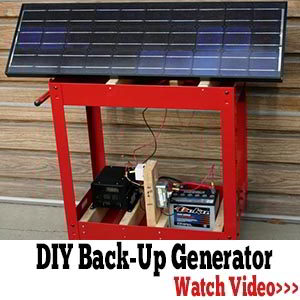 ow To Build A Root Cellar In Your Backyard
ow To Build A Root Cellar In Your Backyard
You Will Not Survive An EMP Strike Without This (Video)
The 5 Seeds That You Need to Stockpile in Your Pantry

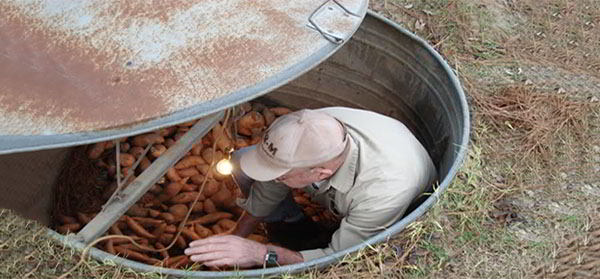
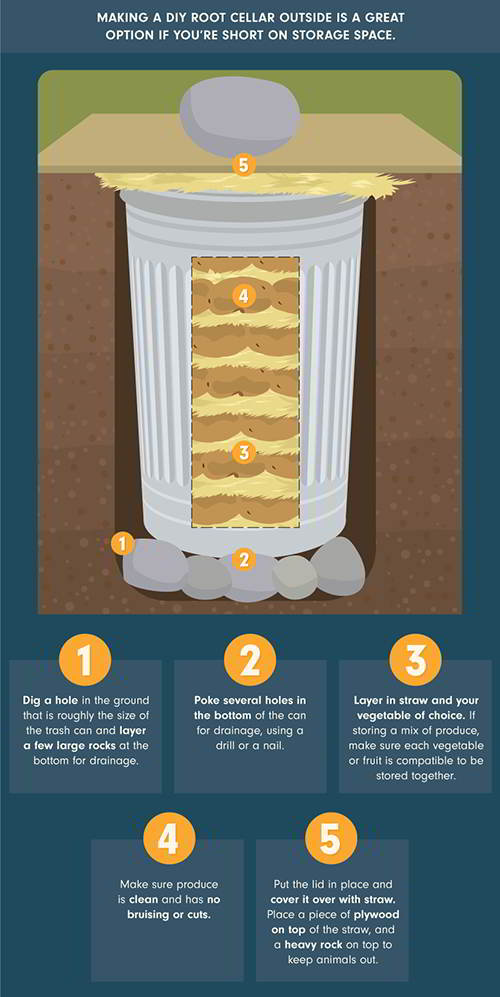













Would it be possible to use burlap sacks to separate different veggies to be stored in the same cellar. Thereby making it easier to access only the veggies you want at any given time ? Would each burlap sack need to be partially filled with straw to separate the veggies within the sack?
Would it be advisable to dig a deep sump hole below the bottom of the cellar to help prevent water rising up into the cellar ?
FYI all burlap sold in the US must have a flame retardant that doesn’t easily wash out. The flame retardant in highly carcinogenic. Don’t use in a bee smoker either
How do you store potatoes in wormer areas. I live in Texas around Austin.
You just need to dig a deeper hole. A shaded area will have cooler soil
I saw a homesteader talking about this last night him his dad and grandpa used metal cans with holes drilled in the bottomed lined layers of food inside with hay between and on top after placing the lid and styrofoam on top with another layer of hay
Muy plan for a root cellar involved sinking an ice chest into the ground. I see that I would have to drill holes in it if I wanted it to work correctly. I also thought that if there were a complete, more or less permanent power failure, why not bury the refrigerator in the ground? It would require a larger hole, but make for a correspondingly larger root cellar.
Anyone have any cons to the above plan? Am I overlooking something?
You must have some good friends or a dolly to tote your fridge around, me thinks. Where would you drill the necessary holes? Would holes not ruin your ‘fridge?
Google the term “buried refrigerator root cellar” or something similar and you will get a lot of links to web sites and YouTube videos. The idea is to use an old “ready for the town dump” fridge that you strip down and recycle for a second, useful, life.
Just a note on this plan. We almost bought a house in fact we were getting ready to go to the closing. My husband who knew government regs. had called the EPA because the guy had a fill spot where he invited folks to drop off their old ice boxes, and then covered it with dirt and grass seed. It made a huge black spot in the yard. EPA informed us that If this would ever flood and run downhill it Could contaminate the neighbors wells, and they could sue you…just sayin
It’s definitely a good idea. I read an article years ago about a guy whose freezer died and decided to bury it underground
https://joyfulhome.wordpress.com/2011/06/26/burying-a-freezer/
I’ll ask for his permission, maybe we can repost it here under his conditions.
My problem is I live in an area filled with rocks. I dig down just 6 inches and I start hitting boulders. No room for any heavy equipment. Difficult task.
Do an above ground root cellar: build a very small room that you can cover with earth, put a door on one end and a small vent at the other end at the top. Dig down as far as you can go. I saw one made of brick and covered with dirt in Nauvoo, Illinois last summer, it was used by the pioneers.
And what would you do about the Freon in it? If it gets a hole and leaks into the ground you got problems
Most people remove freon before doing this project…from instructions i have read anyway.
How do you find out where the freeze line in the ground is?
ask your county extention Agent
Local building inspection department will know.
I know here in Calgary Alberta our frost line is 3′ deep
Southeastern Ohio’s frost line is 18″.
ND is 24″
Call a plumber and ask, he puts pipe in the ground and knows the code. Here in Northern Va, frost line is 24 inches.
What is the purpose of holes in the bottom with drainage problem’s it will just fill up from the bottom if it is buried how can it get air from holes in the bottom.
These are drains. You need to set it above the water table. If your water table is that high you need build an above ground root cellar.
The problem is not the water table it is just rain and clay soil content. I also have nosy untusting neighbors so if a cellar is not hidden it would not be secure. Other problem is flat land.
here in wv to
Your county Ag Agent will know.
I once buried an old non-working refrigerator in the ground to use as a place to raise earthworms for fishing and profit. It’s not at all hard to findnd a junk fridge that can be hauled away for free. As for the holes well its junk anyhow so just drill away
Nice!
Frost in Michigan is6 feet to new specs
I would suggest first dig a hole as deep as you think you need, then cover with a sheet of plywood or similar. Wait a week and then look in the hole. It may have standing water , especially in the rainy season.
MY GRANDMOTHER USED SAW-DUST INSTEAD OF STRAW. I REMEMBER DIGGING THRO. THAT TO GET POTATOES, CARROTS AND I THINK ONIONS FROM OUR GARDEN. IT WAS IN A DEEP WOODEN CONTAINER IN HER SELLER. SO I THINK ONE COULD USE SAW-DUST IN YOUR IN THE GROUND CONTAINER INSTEAD OF STRAW. THAT WOULD BE EASIER TO GET YOUR FRUIT OR VEGGIES OUT.AND LAST LONGER THAN STRAW.
Make sure you thoroughly know the source of your sawdust. Treated and “Engineered” wood (sawdust) would likely be toxic.
Sawdust from pine, cedar, or other woods may affect the taste, as well. Sappy woods, well…
Built one many years ago by burying 50 gal. drums on their sides into a hillside and used homemade wooden doors . The contents stayed buried in sand and kept all winter. Neighbors thought me loony but it worked. A Mother Earth News project circa 1973. Jesus is Lord!
storing potatoes my grand parents in florida stored then in pine straw .Grand pop built a box oitb of wood and across the bottom he put small mesh chicken wire. then layer of straw,,layer of potatoes layer of straw untill all stored..this was in centeral florida
Hello, our soil is heavy clay and I wonder whether this would work in that kind of soil? The digging part is fine, just wondering about drainage.
Not so sure about using a galvanized can for storing food. I would use a different type of can.
New Mexico along the East to West I-40 line, frost line is 18″ – 24″depending on elevation. I live along the base of a mountain. Back in the late 70s I built a 4′ in ground, 4′ above ground earth bermed cinderblock food storage room. It was awesome. Nothing froze. It was cool and only slightly moist year around. Folks are still using it.
This time I plans to dig 6′ and cover the complete room with dirt. Construction will be cinderblock or aircrete. Roof 4′ reinforced cement. Entrance door will be a chest. Freezer with the entire bottom removed and the door modified to open from inside and outside. It will sit at a laid back angle much like old time storm cellars were as you open to steps, not level ground. It will need a simple vent but really moisture isn’t a big problem in high mountain desert country.
I also have a freezer built like a slide in camper for a truck. It can run on 110 or 12 volt power using an old square based Ford compressor. It is walk in height. I plan to also burry it sitting on a 6″ gravel base and mound dirt over it. A simple solar trickle charger will keep a battery charged enough to run the compressor now and then to maintain 5*f temp. It already has 6″ deep fiberglass insulated sides, roof, and door. I used to maintain icecream and meats for a week long event by running it 30 minutes twice a day in 100+ summer days and being opened many times a day. Burried and only open occasionally it will not need to run often but the compressor unit will have to be covered with a wooden box not dirt. It needs to stay clean and have access to air. It was built so the compressor sat over the truck cab when used. I have it on a small trailer as that was easier for me to use. I plan to add a hitch to my old golfcart to use the trailer when I’m work around the current property. I’ll make a wood bed on the trailer. Currently the freezer sits on the c channel frame.
Check around for old food transport freezers and refrigerators. They don’t run forever. They are larger than most home freezers or refrigerators and have to be better insulated. My freezer still runs and is still easy to keep it going if… you need old Ford compressors and new fill up of freeon if you do much work on it.
Dirt is a great insulator. A friend lives in a home burried 6′ with a South facing 12′ row of 2’x2′ Windows then 18″ air space and another matching set of Windows for heat just open an inner window. For venting heat open inner and outer Windows. They have a back up wood Heater but it is seldom used. Roof is insulated but walls are totally encased in the dirt so no further insulation is needed. Other than roof maintenance it has been a good home for 48 years. The well is inside a corner of the kitchen with an insulated hatch in the roof in case the pump ever has to be pulled. It has been replaced twice so it was a good plan.
Homes here have been built with Adobe 18″ – 24″ think walls and oldest home had 6″ – 9″ dirt on top of the roof. They are maintained for generations. Dirt here is hard as a rock with some clay content. Openings with shutters brought needed cooling breezes and were thick enough to protect from below zero winter temperatures. Simple fireplaces and later wood heaters add heat and cooking areas.
Dirt is a great insulation material!
I would love to have more details on your friends house underground.
Hi, I would love to purchase four copies of “Darkest Days” with the other free bonuses noted. However there was no button to click on in order to purchase these copies. Can you please either get back to me by email. I love my family, and also want to start a community project in my small town, by educating them with this information. Thanks.
Hello
I have this design with a plastic bin and have found that the straw was damp and mouldy after a week. There’s been no rain in a month. Any advice?
My temporary root cellar for this year is a 55 gal plastic drum with a removable top and extra ring to hold it closed. Buried with a berm buiilt up around around it. The top is just higher than the berm. It keeps out rain water. It’s well sealed and hay gets layered in it as things are added. I plan on a half pit but fully dirt covered room next year.
The last one like that worked wonderfully and stayed cool all summer and didn’t freeze in winter. It stayed about 40 degrees year around.
Is yours protected from the sun? Mine gets generally covered over because our chickens kick dirt all over the lids all day but it still get the sun through most of the day. I’ll be checking on my second bucket in a few days to see if letting the beets dry out more along with very dry straw has helped. I’ve thought about the traditional above ground clamp but the fox, rats, cat and our chickens would destroy that in one night!
My barrel in using this year is in shade most of the day. It’s doing pretty good but I want to get the pit room built.
to bury a refridgerater or ice box you need to remove the motor out of the frame so it will not leach freon or oils into the ground then the epa will not know to jump you because when the motor rots it lets all the freon loose and that is what kills the grass an polutes the water
Trash can in the ground with holes in the bottom—– REALLY BAD IDEA! In the spring time, with lots of rain and snow melt, that can will totally fill with water and ruin everything inside. It might also simple float out of the ground unless you have bricks in it. Better to use a plastic barrel and better to use ground anchors to secure it into the gound so it can’t float up.
When I was growing up in Tenn my father dug down in the crawl space under the house (avoiding the supports) deep enough to store bushel baskets full of potatoes and apples pack in straw over the winter.
If I put holes in the bottom of the barrel it would fill up with rain water from the saturated ground. Last time i dug a 4 deep hole after a rain it had 3 feet of water in it! And yes I was building a root cellar ended up refilling it.
We live in Tampa FL area. Soil is mainly sand. Don’t have freeze line, instead worry about the ground being too warm. What would you suggest for a small root cellar here? Probably will use for potatoes, onions, maybe broccoli. Also, what is best way to store various dried beans here?
Or saturated with water, after a hurricane. Same problem in Houston TX area
I was thinking about burying an old freezer and using it as a root cellar should it be sitting on rocks and should i drill holes in the bottom for drainage
Found this National Weather website map that shows freeze line but I’m not sure I’d agree with it. It shows Texas as 6″ however, I’ve found an article on an Austin.gov site that says up to 2 feet. Pipes are required to be buried 2 feet her, on homes.
forgot the url Frost Depth